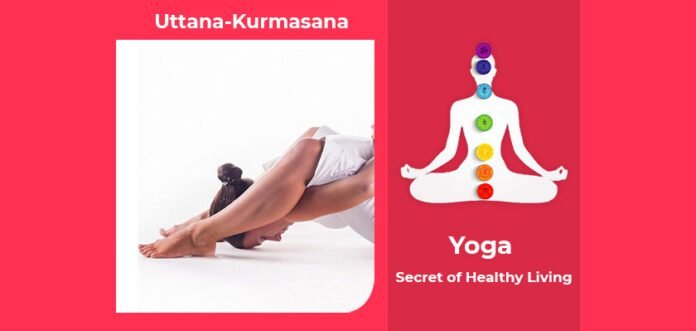What is Uttana Kurmasana
Uttana Kurmasana Kurma’ means tortoise. In the first stage the arms outstretch on either side of the body, the legs are over the arms, the chest and shoulders on the floor.
- This is the tortoise with his legs folded. In the next stage the hands are brought behind the body, palms facing up.
- This final stage of the pose resembles a tortoise withdrawn into its shell, where the feet curl together in front of the head, and the hands close over the buttocks.
Also Know as: Upside-down Tortoise Posture, Kachhua or Kachua Asan, Uttan Kurm Asan, Uttana Karma Asana, Intense or extended Tortoise posture
How to start this Asana
- Start from the position of Vajrasana .
- Now take a forward bend and rest your head on the ground.
- Let your nose closer to your knees and streatch your arms back to your feet.
- Your hands and feet should rest parallel to each other and palms should be facing upwards.
How to end this Asana
- To release: slowly come back to the first position and relax.
Video Tutorial
Benefits of Uttana Kurmasana
According to research, this Asana is helpful as per below(YR/1)
- Tortoise opens the hips and stretches the thighs, back, and shoulders.
- This posture draws the focus of the mind inward and promotes surrender, inner security and tranquility.
Precaution to be taken before doing Uttana Kurmasana
As per several scientific studies, precautions need to be taken in diseases mentioned as per below(YR/2)
- Not for the persons who have recent or chronic injury to the hips, arms or shoulders.
So, consult your doctor if you have any of the problem mentioned above.
Histroy and scientific base of Yoga
Due to the oral transmission of sacred writings and the secrecy of its teachings, yoga’s past is riddled with mystery and confusion. Early yoga literature were recorded on delicate palm leaves. So it was easily damaged, destroyed, or lost. Yoga’s origins may be dated back over 5,000 years. However other academics believe it could be as old as 10,000 years. Yoga’s lengthy and illustrious history may be split into four distinct periods of growth, practise, and invention.
- Pre Classical Yoga
- Classical Yoga
- Post Classical Yoga
- Modern Yoga
Yoga is a psychological science with philosophical overtones. Patanjali begins his Yoga method by instructing that the mind must be regulated – Yogahs-chitta-vritti-nirodhah. Patanjali does not delve into the intellectual underpinnings of the need to regulate one’s mind, which are found in Samkhya and Vedanta. Yoga, he continues, is the regulation of the mind, the constraint of the thought-stuff. Yoga is a science based on personal experience. The most essential advantage of yoga is that it helps us to maintain a healthy bodily and mental state.
Yoga can help to slow down the ageing process. Since aging starts mostly by autointoxication or self-poisoning. So, we can considerably limit the catabolic process of cell degeneration by keeping the body clean, flexible, and properly lubricated. Yogasanas, pranayama, and meditation must all be combined to reap the full advantages of yoga.
SUMMARY
Uttana Kurmasana is helpful in increase flexibility of muscles, improves shape of the body, reduce mental stress, as well improves overall health.




